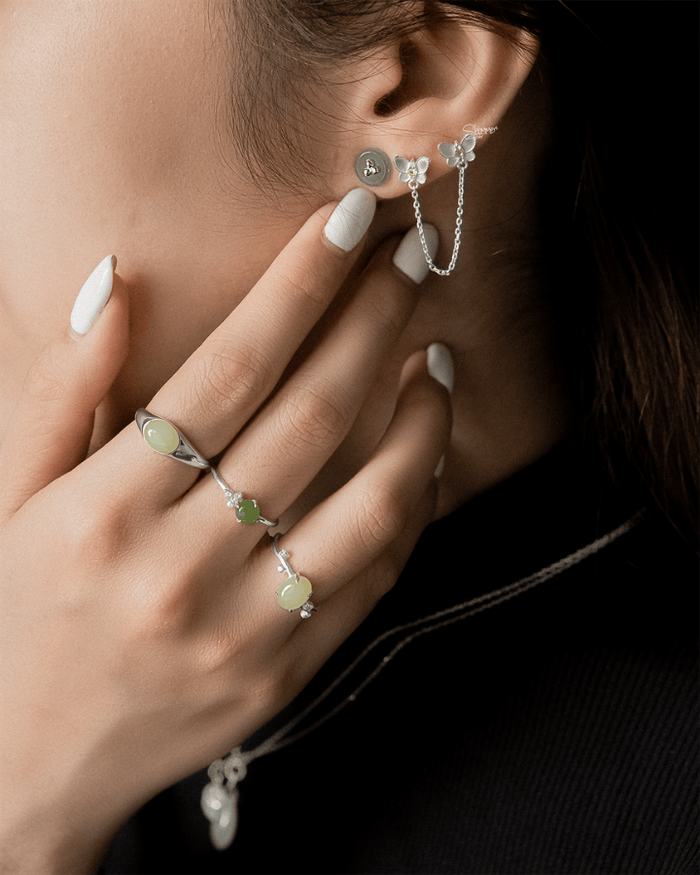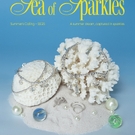Jade — a stone of serenity and spiritual grace — has captivated hearts for millennia.
Unlike the brilliance of diamonds or the dazzling play of opals, natural jade radiates a calm and timeless beauty. It holds not only the essence of the earth but also the spirit of harmony and good fortune.
In this article, we’ll explore what jade truly is, how to recognize genuine jade, and the profound meanings and applications that have made it one of the world’s most cherished gemstones.
🌿 What Is Jade Gemstone?
Natural Jade is one of the most meaningful names in the world of gemstones.
Unlike the brilliance of diamonds or the shifting hues of opals, jade carries within it a quiet beauty — gentle, pure, and deeply spiritual. It is treasured not only for its appearance but for its mysterious ability to nurture emotions, soothe the soul, and attract good fortune. Jade transcends mere material value; it is a spiritual companion.
The term “Jade” is actually a collective name for two minerals that look similar but differ in chemical composition between Jadeite (Cẩm thạch), Nephrite (Ngọc bích)
This distinction is not only scientific — it also directly affects the aesthetic and commercial value of each type.
🗻 History and Characteristics of Jade
🌿 A History Stretching Back Through Millennia
Since ancient times, people have believed that “Humans nurture jade for three years – jade nurtures humans for a lifetime.”
Jade has long been regarded as a sacred treasure deeply intertwined with the human spirit. When cherished with respect and care, it becomes a silent guardian — believed to embody pure energy drawn from the earth and sky.
Unlike many other gemstones that dazzle with showy brilliance, jade radiates a calm and profound beauty — a symbol of purity, peace, and inner balance.
In early history, Nephrite (Ngọc bích) was widely used in China for tools, ritual items, and ornaments.
It wasn’t until the 18th century that Jadeite rose to prominence, when explorers brought it from Myanmar to China. The Qing nobility soon fell in love with its vibrant color and translucency, elevating it to imperial status.
🌍 Main Jade Sources Around the World
Myanmar (Burma) – The finest quality Jadeite in the world, especially the legendary Imperial Jade.
China – Known for Nephrite mined for thousands of years, particularly from Xinjiang and Henan.
Canada – One of the largest suppliers of Nephrite jade today.
Russia – Abundant Nephrite deposits in Siberia.
Guatemala – Famous for its rare bluish Jadeite.
🔍 Distinctive Features of Jade
🎨 Color
Jadeite (Cẩm thạch) – rarer, harder, and more lustrous, with vivid emerald-green hues and occasional touches of lavender, pink, or orange.
Nephrite (Ngọc bích) – more common, with gentle tones of moss green, creamy white, or soft gray.
Authentic jade often shows natural variations in tone and subtle veins — never perfectly uniform.
💎 Transparency
- Ranges from opaque to semi-translucent, creating a gentle, glowing depth.
- Under light, the glow diffuses softly within rather than shining straight through.
- Upon close inspection, you can see fine fibrous or cloud-like patterns — a hallmark of natural jade.
🪨 Structure and Hardness
Jade’s microscopic fibrous or granular interlocking structure gives it extraordinary toughness.
While not as hard as diamond or quartz, jade is extremely tough and resistant to breaking — it rarely cracks under minor impact.
❄️ The Feel of Jade
What makes jade truly magical is not only its composition but also the feeling it gives when touched — a calm, cooling sensation, as if the stone still holds the breath of the earth from millions of years ago.
Real jade feels naturally cool to the touch, even in warm weather, with a comfortable weight — not light like glass or plastic imitations.
✨ III. Symbolism and Emotional Significance of Jade
The symbolic meaning of jade extends across civilizations, from Asia to the Americas.
Jade embodies layers of subtle significance — reflecting profound cultural, emotional, and spiritual values. From East to West, from ancient empires to modern societies, jade remains an enduring symbol of serenity, connection, and timelessness.
1. Ancient China – Where Jade Became the “National Gem”
For thousands of years, the Chinese have revered jade as a sacred emblem representing virtue, moral integrity, and wisdom.
Confucius once wrote:
“The gentleman compares himself to jade.”
This phrase captures jade’s elevated place in Confucian philosophy — symbolizing refinement, righteousness, and benevolence.
A true gentleman admires jade because it shines without dazzling, is strong without being harsh, and soft without weakness — much like the balanced temperament of a virtuous man.
From ceremonial rituals and musical instruments to royal attire and burial rites, jade was present in every sacred aspect of life. It was believed to protect the soul, ward off evil, and promote health and longevity.
In the 18th century, when Jadeite from Myanmar was introduced into China, the Qing aristocracy became enamored with its brilliant translucence and vivid hues. The finest variety, a vibrant emerald-green jadeite, became known as “Imperial Jade” — treasured for its rarity and unmatched beauty.
2. Ancient Mesoamerica – The Stone of Gods and Power
In Central America, particularly among the Maya and Aztec civilizations, jadeite was considered more precious than gold.
The Maya believed jade connected humanity to the divine and symbolized immortality. Kings and priests adorned themselves with jade during sacred ceremonies, and it was often buried with the dead to accompany their souls into the afterlife.
3. Other Cultures
The Maori people of New Zealand used Nephrite jade (Pounamu) to craft weapons, amulets, and ornaments. Pounamu is seen as an ancestral treasure, passed down through generations.
In ancient Egypt, jade was carved into protective amulets.
In Russia and Europe during the 18th–19th centuries, jade became popular among royalty and aristocrats, featured in fine decorative art — notably in the masterpieces of the House of Fabergé.
🕊️ A Symbol of Peace and Inner Balance
The soft, serene green of jade evokes calmness and emotional balance.
In today’s fast-paced, chaotic world, wearing or keeping jade serves as a gentle reminder to pause, breathe, and restore harmony within oneself.
💖 Strengthening Bonds and Lasting Relationships
Jade has long symbolized pure and enduring love and friendship.
As a gift, it conveys trust, understanding, and deep connection — whether between lovers, family members, or friends.
🌿 A Reflection of Inner Strength and Resilience
Jade’s quiet grace conceals profound strength.
It doesn’t flaunt its beauty — it endures.
Those who wear jade often embody the same spirit: grounded, composed, and unwavering in their values.
💰 A Symbol of Prosperity and Steady Growth
In many Eastern traditions, jade represents stability, abundance, and good fortune.
It isn’t about magical beliefs, but rather a symbolic expression of diligence, perseverance, and balanced growth — a wish for a fulfilled and sustainable life.
👑 Celebrating Health and Harmony
With its natural coolness and smooth texture, jade was once used to craft royal items — jade cups, pillows, and ornaments — representing nobility and balance.
Even today, jade serves as a gentle reminder of the value of slow living, holistic well-being, and inner serenity.
💮 IV. Using Jade Effectively
To fully embrace the spiritual and energetic benefits of jade, keep these practices in mind:
🤲 Wear it close to your skin:
Direct contact allows the stone’s energy to harmonize naturally with your body.🧘♂️ Place jade near meditation or workspace areas:
It promotes focus, calmness, and mental clarity.🌙 Regular cleansing and recharging:
Rinse gently under clean water or place under the full moonlight to refresh its energy.🔄 Harmonize with other Feng Shui elements:
Avoid combining jade with items incompatible with your personal energy or zodiac element.💬 Keep a peaceful, sincere mindset:
Jade resonates best with those who carry calmness and gratitude in their hearts.
💎 V. Distinguishing Real Jade from Imitations & Caring for Your Gem
🔎 How to Tell Real Jade from Fake
In today’s diverse gemstone market, distinguishing genuine jade from artificial substitutes requires a discerning eye. Here are simple yet effective ways to recognize authentic jade:
❄️ Cool to the touch:
Real jade feels naturally cool and refreshing, even at room temperature.🔍 Natural patterns:
Authentic jade often has subtle veins or cloudy inclusions, unlike the perfectly uniform color of fake stones.💡 Under light:
Fake jade often appears too transparent or has a harsh, glassy glow without depth.💵 Price awareness:
If it’s unusually cheap or unnaturally vivid in color, it’s likely dyed or treated.
Expert Tip:
For valuable jewelry pieces, always purchase from reputable dealers that provide authentic gem certification to ensure quality and value.
🧼 Caring for Your Jade – Keeping Its Natural Beauty
Although jade is durable, it still deserves gentle care to maintain its glow and pure energy:
-
🧽 Wipe regularly with a soft cloth; avoid strong detergents or stiff brushes.
-
💧 Do not soak jade in water for long periods, especially in soapy or chemical solutions.
-
☀️ Keep away from direct sunlight and extreme heat to prevent color fading or cracking.
-
👜 Store separately to avoid scratches from metal or other gemstones.
-
🧴 Avoid contact with perfume or cosmetics to preserve its natural luster.
Pro tip: Occasionally apply a thin layer of olive oil on the surface to keep your jade radiant and supple, as if newly polished.
🪞🪄All stones are symbolic and intended for emotional support only✨
.png)
.png)
.png)
.png)
.png)
.png)
.png)
.png)
.png)
.png)
.png)
.png)
.png)
.png)
.png)
.png)


.png)




.jpg)
